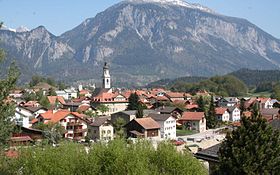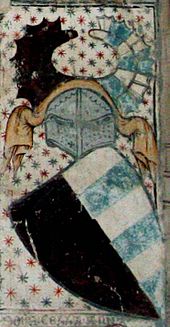Rhäzüns
| Rhäzüns | |
|---|---|
| State : |
|
| Canton : |
|
| Region : | In the ground |
| BFS no. : | 3723 |
| Postal code : | 7403 |
| Coordinates : | 749 715 / 185 075 |
| Height : | 657 m above sea level M. |
| Height range : | 593–1998 m above sea level M. |
| Area : | 13.37 km² |
| Residents: | 1496 (December 31, 2018) |
| Population density : | 112 inhabitants per km² |
| Website: | www.rhaezuens.ch |
|
Rhäzüns |
|
| Location of the municipality | |
Rhäzüns ( Romansh Razén ) is a municipality in the Imboden region of the canton of Graubünden in Switzerland .
geography

Rhäzüns lies on the lower reaches of the Hinterrhein before its confluence with the Vorderrhein .
history
Rhäzüns was first mentioned in a document in 840 as Raezunne . With Bonaduz , Rhäzüns originally formed a parish with St. George as the parish church. 1529–1667 the two communities were gradually separated. Since the establishment of the Upper or Gray League in 1424, Rhäzüns formed a court with the communities of Bonaduz, Ems and Felsberg . With the same-named rule of Rhäzüns , the community came from the Zollern to Habsburg after 1497 , but remained part of the Three Leagues. The new ruler Maximilian I and his successors first gave the rulership as pledges to various local families such as the Marmels, the Planta , the Stampa or the Travers. From 1696 the rule was administered directly by the Habsburgs. After the Congress of Vienna , Rhäzüns finally came to the Canton of Graubünden in 1819 .
Today's parish church Nossadunna (Mary's birth) was built in 1702 with contributions from Mr. von Rhäzüns, the German Emperor Leopold I. The mineral spring has been used commercially since 1850 and gave the Rhäzünser mineral water its name.
coat of arms
Blazon : Split of red and blue, two silver (white) bars in blue
Adoption of the coat of arms of the Barons of Rhäzüns .
population
| Population development | |||||||||||
|---|---|---|---|---|---|---|---|---|---|---|---|
| year | 1850 | 1900 | 1950 | 1980 | 1990 | 2000 | 2005 | 2010 | 2012 | 2014 | 2016 |
| Residents | 508 | 495 | 774 | 958 | 1018 | 1201 | 1220 | 1300 | 1344 | 1371 | 1463 |
languages
Originally the residents spoke a Romansh dialect. Although this was a Central Grisons dialect, Surselvic was traditionally used as the written language in all communities in the Imboden district . In this capacity they were similar to the communities of Bergün and Filisur , where dialects of the Central Graubünden were or are also in use, but Upper Engadin was in use as the written language (there, historically, mainly for religious reasons).
Despite the constant growth of German, Romansh remained the majority language until 1970. But the proportion fell from 1880 96% over 1910 82% and 1941 76% to 1970 52% (or 466 people). In the 1970s the language changed to German, which is becoming more and more dominant. This is also confirmed by the following table (the values for 1990 are not exact):
| Languages in Rhäzüns | ||||||
| languages | 1980 census | 1990 census | 2000 census | |||
| number | proportion of | number | proportion of | number | proportion of | |
| German | 486 | 50.73% | approx. 615 | approx. 60% | 953 | 79.35% |
| Romansh | 369 | 38.52% | approx. 313 | approx. 31% | 121 | 10.07% |
| Italian | 82 | 8.56% | about 40 | approx. 4% | 40 | 3.33% |
| Other | 21st | 2.19% | approx. 50 | approx. 5% | 87 | 7.24% |
| Residents | 958 | 100% | 1018 | 100% | 1201 | 100% |
Although 23.5% of the population still understand Romansh, German is the only official language today. The Italian speakers are not Italian allies, but immigrants from Italy.
Origin and nationality
Of the 1220 residents at the end of 2005, 1029 (= 84%) were Swiss citizens.
traffic
Rhäzüns is by a post bus line , the bus Chur and a station of the railway line Landquart-Thusis the Rhaetian Railway connections to public transport. A cable car leads over the Rhine to Feldis / Veulden .
economy
The place is best known for its Rhäzünser mineral water . The advertising slogan “Rhäzünser isch gsünser” could be read for years in TV advertising and on the trucks of the mineral water company.
Attractions
- Sogn Gieri church (St. Georg): mentioned as early as 960; Romanesque church with Gothic choir; complete painting from the 14th century a. a. by the Waltensburg master .
- Former parish church and today's cemetery church Sogn Paul
- Parish Church of Nossadunna (Birth of the Virgin): built in 1697, baroque.
- Rhäzüns Castle : in the Middle Ages ancestral seat of the powerful barons of Rhäzüns . Rhäzüns Castle is owned by Ems-Chemie and serves Christoph Blocher as a second home. As an alternative to today's private use, there were also ideas to make the facility accessible to the public.
literature
- Erwin Poeschel : The art monuments of the canton of Graubünden III. The valley communities Räzünser Boden, Domleschg, Heinzenberg, Oberhalbstein, Upper and Lower Engadine. (= Art Monuments of Switzerland. Volume 11). Edited by the Society for Swiss Art History GSK. Bern 1940. DNB 760079625 .
- Armon Fontana: Swiss Art Guide GSK, Volume 755: The churches of Rhäzüns: Nossadunna - Sogn Paul - Sogn Gieri , Bern 2004, ISBN 3-85782-755-6
- Linus Bühler: Rhäzüns (community). In: Historical Lexicon of Switzerland . 2011 .
- Linus Bühler: Rhäzüns (rule). In: Historical Lexicon of Switzerland . 2017 .
- Rhäzüns, Freiherrschaft, Austrian enclave, Bündner Kreis , SO-Buchverlag, 2018, ISBN 978-3-7298-1201-7 .
Web links
- Rhäzüns on the ETHorama platform
- Official website of the municipality of Rhäzüns
- History and pictures of Rhäzüns Castle
Individual evidence
- ↑ Permanent and non-permanent resident population by year, canton, district, municipality, population type and gender (permanent resident population). In: bfs. admin.ch . Federal Statistical Office (FSO), August 31, 2019, accessed on December 22, 2019 .
- ↑ Lia Rumantscha (Ed.): Romansh - Facts & Figures. 2nd, revised and updated edition. Chur 2004, ISBN 3-03900-034-9 . P. 31.
- ↑ Catholic Church Parish Church of St. Mary's Birth
- ^ Armon Fontana: The churches in Rhäzüns. Nossadunna - Sogn Paul - Sogn Gieri. (Swiss Art Guide, No. 755, Series 76). Ed. Society for Swiss Art History GSK. Bern 2004, ISBN 978-3-85782-755-6 .
- ^ Rhiiblatt, August 20, 2002: Rhäzüns Castle remains closed.











